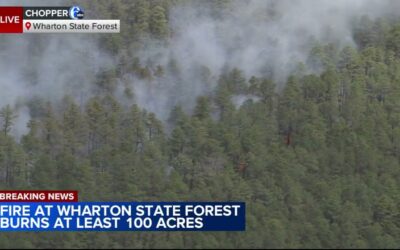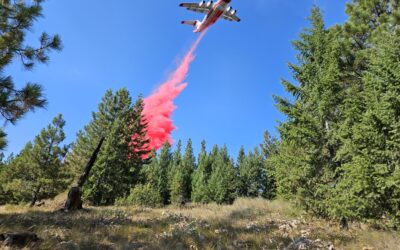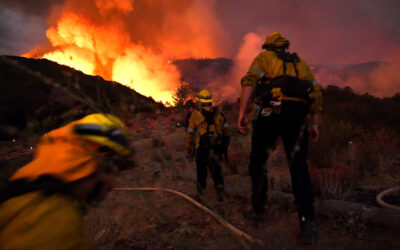Mary Callahan – The Press Democrat
Dec. 12—Scientists at Stanford University have revealed yet another reason to be alarmed by exposure to wildfire smoke and the ash and dust left behind by high intensity fires.
It turns out that catastrophic wildfires like those experienced across the North Bay can transform a naturally occurring metal in rock, soil and plants into the toxic, carcinogenic stuff that put environmental activist Erin Brockovich on the map: chromium 6, or hexavalent chromium.
The new study, published Tuesday in the journal “Nature Communication,” was based on research samples taken locally, in the footprints of the November 2019 Kincade Fire and the Hennessy Fire, part of the LNU Lightning Complex that broke out around the region in fall 2020.
Residents along Chiles-Pope Canyon Road watch the Hennessy fire blow toward them as thunderstorms winds kick the flames up, Monday, Aug. 17, 2020 in Napa County. (Kent Porter / The Press Democrat) 2020
It found that high heat drastically accelerates the conversion of naturally occurring heavy metal called chromium 3 into chromium 6, particularly in metal-rich geologic areas, like serpentine, which is common to the North Coast Range.
Production of the toxic form also is amplified by abundant fuels and certain plant types, like chaparral and forest, both because they raise the temperature of the fire and provide greater volumes of chromium 3 to transform.
Cal Fire’s Hood Mountain crew navigate steep rocky terrain as they cut line around the Dollar Fire, Friday, Nov. 10, 2023 in Napa County’s Pope Valley, adjacent to St. Supery Vineyards. The fire burned within the 2020 Hennessy Fire scar. (Kent Porter / The Press Democrat) 2023
Particles of chromium 6 can then be transported in the smoke or lie on the ground in surface soil for nearly a year, or until a sufficient rainfall dilutes it back into the soil, said Scott Fendorf, professor of Earth System Science at Stanford and senior associate dean of Integrative Initiatives at the Doerr School of Sustainability
“In addition to local (and possibly distal) communities that may be exposed by transport of Cr (VI)-bearing PM (particulate matter) during and after wildfires, wildland fire crews and first responders are particularly at risk,” the paper states. “Given the persistence of Cr (VI) after wildfires, continued dust exposure serves as a continued human health threat to land workers, recreationalists, and local residents.”
That’s particularly true if whatever they’re doing on a site with high chromium 6 levels stirs up or disrupts the soil, Fendorf said. Stanford postdoctoral researcher Alandra Marie Lopez and Research Associate Juan Lezama Pacheco were co-authors.
The risk is marked for wildland firefighters, who often hike around in fire zones with out the respirators common to urban firefighters and take in more toxic smoke through their lungs and even through their skin.
“They wear a bandanna at best, right?” said Fendorf. “And I recognize for them, the risk calculus probably isn’t going to change it.”
But for others, “your risk calculation could make quite a big difference.”
Steve Smith takes a rest from raking leaves near his home in Santa Rosa, as he wears a mask because of the Camp fire in Butte County, Thursday, Oct. 8, 2018. (Kent Porter / The Press Democrat) 2018
The study should encourage people to wear masks, especially N-95s, any time there’s smoke in the air, if they go outside and to try to stay indoors, with an air purifier running, Fendorf said.
“All the things we actually hear from the health community? You should just take that way more seriously,” he said.
The kind of rock in the burning or burned landscape matters, though, based on sampling across different geologic zones. Granite, for instance, has far lower metal content than what are called mafic or ultramafic rock areas.
In what is ultimately a call for more investigation — and a warning to those who work in, around and after wildfires — the new paper notes significant awareness around the cancer-causing toxins contained in smoke from structure fires, as a broad range of chemicals and substances incinerate.
The wildland equivalent is less understood and “under appreciated,” the study says.
The new research is one of many studies spurred by a spate of catastrophic wildfires that erupted around California over the past decade and did particular damage in the North Bay, burning hundreds of thousands of acres around the Sonoma, Lake, Napa and Mendocino counties since 2015.
Previous studies investigated the health hazards from particulate matter in smoke, the risk of cardiac arrest and stroke to patients with vascular disease, prolonged respiratory problems from smoke exposure and high mercury levels in firefighters’ blood.
Firefighters already live with known for many types of cancer — the leading cause of death for those in the profession. They have a 9% higher risk than the general populace of being diagnosed with a cancer and a 14% higher risk of dying from cancer, according to the Centers for Disease Control and the National Institute for Occupational Health and Safety.
Changes under way to reduce exposure include laundry facilities at incident bases so firefighting turnouts can be washed, as well as a push for more facilities that allow regular cleaning and decontamination, Cal Fire Division Chief Ben Nicholls said.
But firefighting “is the profession that we’ve chosen,” he said, “and we understand there are higher risks that we face that average folks don’t.”
Chromium 6, made notorious by Brockovich, who was played by actor Julia Roberts in the 2000 film that bears the activist’s name, is a highly toxic substance used or produced in a host of industrial and manufacturing settings, including chrome plating, textile dies, pains, casting, welding, leather tanning, surface coating and cutting stainless steal.
It can be inhaled or ingested, or passed by pregnant people to their babies, causing ear, throat and nose irritation, as well as lung, nasal and stomach cancers, depending on the path of exposure, according to the California Office of Environmental Health Hazard Assessment.
Often, it leaches into groundwater, as did the chromium 6 from a Pacific Gas & Electric compressor station that sickened the residents of Hinkley and earned Brockovich’s attention.
The new Stanford study was conducted by scientists who started out questioning whether fires might cause chromium 6 to leach into groundwater. They soon “began realizing that the risk, which turns out to be really great, is in the dust,” Fendorf said.
While ingesting the substance is bad, however, “breathing it is catastrophic,” Fendorf said.
Virginia ‘Ginny’ Fifield is a volunteer with the Maycamas / Modini preserve who own owns and maintains several wildlife cameras off Pine Flat Road. (Kent Porter / The Press Democrat)
Samples sites included the Audubon Canyon Ranch’s 3,125-acre Modini Preserve off Pine Flat Road near The Geysers; the 3,200-acres Pepperwood Preserve in the Mayacamas Mountains; the Sonoma Land Trust’s 92-acre White Rock Preserve northeast of Healdsburg and the University of California’s McLaughlin Natural Reserve in southeast Lake and Napa counties.
You can reach Staff Writer Mary Callahan (she/her) at 707-521-5249 or [email protected]. On X/Twitter @MaryCallahanB.
___
(c)2023 The Press Democrat (Santa Rosa, Calif.)
Visit The Press Democrat (Santa Rosa, Calif.) at www.pressdemocrat.com
Distributed by Tribune Content Agency, LLC.




